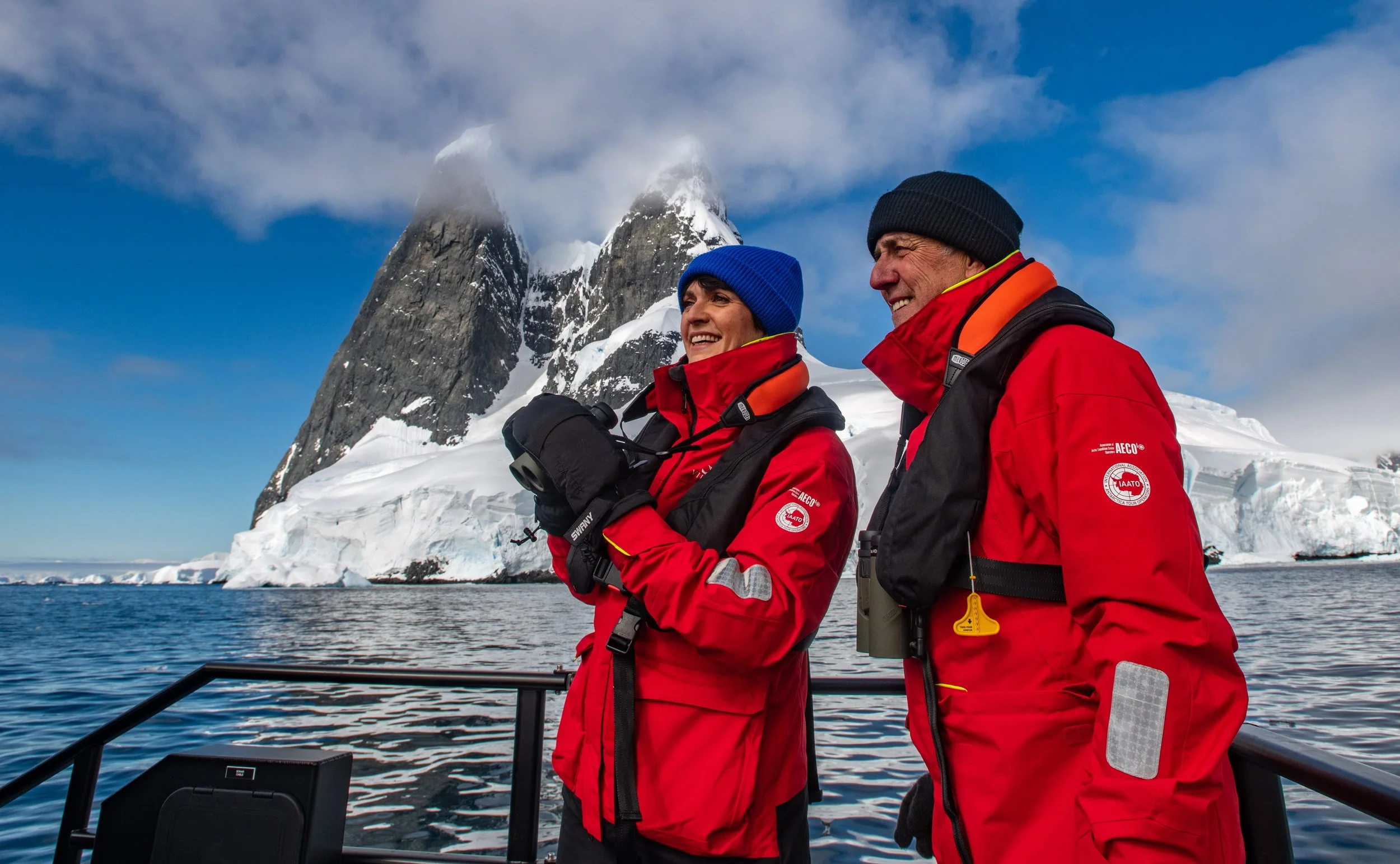What to Pack for an Antarctica Cruise
Antarctica's breathtaking beauty comes with extreme conditions that require careful preparation and specialized equipment to ensure family comfort, safety, and enjoyment throughout polar expedition experiences.
Proper packing can transform challenging polar conditions into comfortable adventure opportunities while inadequate preparation can significantly impact expedition enjoyment and family safety in Earth's most remote wilderness.
Professional packing guidance ensures families arrive prepared for Antarctic conditions while maintaining comfort standards and maximizing wildlife viewing and cultural experiences throughout polar cruise adventures.
Understanding Antarctic Conditions
Antarctic weather presents unique challenges that require specialized clothing systems, protective equipment, and careful preparation to ensure family comfort during expedition activities and wildlife viewing opportunities.
Conditions vary significantly based on season, location, and weather patterns, requiring flexible packing strategies that accommodate changing temperatures, wind conditions, and precipitation throughout cruise experiences.
Antarctic Climate Considerations:
• Temperature ranges from 20°F to 45°F (-7°C to 7°C) during cruise season
• Wind conditions can create significant windchill effects requiring protection
• Precipitation includes snow, sleet, and rain requiring waterproof protection
• UV exposure from snow reflection requiring comprehensive sun protection
• Humidity levels affecting comfort and equipment performance
• Rapid weather changes requiring adaptable clothing systems
Essential Clothing Systems: The Foundation of Comfort
Antarctic clothing requires layered systems that provide warmth, moisture management, and weather protection while maintaining flexibility for varying activity levels and changing conditions.
Professional clothing coordination ensures families understand layering principles while selecting appropriate garments that provide optimal comfort and protection throughout expedition activities.
Base Layer System: Moisture Management
Base layers provide essential moisture management and thermal regulation that form the foundation of effective Antarctic clothing systems.
Base Layer Requirements:
• Merino wool or synthetic materials that wick moisture and retain warmth when wet
• Avoid cotton fabrics which retain moisture and lose insulation properties
• Multiple sets allowing for daily changes and washing rotation
• Comfortable fit that allows freedom of movement without restriction
• Seamless construction preventing chafing during extended wear periods
• Odor resistance for extended expedition wear without washing opportunities
Insulation Layer: Warmth and Versatility
Insulation layers provide essential warmth while allowing temperature regulation through addition or removal based on activity levels and weather conditions.
Insulation Layer Options:
• Down jackets providing maximum warmth-to-weight ratio for cold conditions
• Synthetic insulation maintaining warmth when wet and drying quickly
• Fleece garments offering versatility and easy temperature regulation
• Vest options providing core warmth while maintaining arm mobility
• Lightweight options for layering and temperature adjustment
• Packable designs allowing easy storage when not needed
Outer Shell: Weather Protection
Outer shell garments provide essential protection from wind, precipitation, and marine conditions while maintaining breathability and freedom of movement.
Shell Layer Specifications:
• Waterproof and breathable fabrics protecting from precipitation and ocean spray
• Wind resistance preventing heat loss and providing comfort during exposure
• Sealed seams ensuring complete weather protection in extreme conditions
• Ventilation options allowing temperature regulation during active periods
• Durable construction withstanding expedition activities and equipment interaction
• Bright colors enhancing safety and visibility during expedition activities
Footwear: Foundation for Antarctic Exploration
Antarctic footwear requires careful selection that provides warmth, waterproofing, and traction while maintaining comfort during extended expedition activities and varying terrain conditions.
Professional footwear coordination ensures families select appropriate options that provide safety and comfort while accommodating expedition requirements and personal preferences.
Waterproof Boots: Essential Protection
Waterproof boots provide essential protection during zodiac operations, shore landings, and deck activities while maintaining warmth and comfort in extreme conditions.
Boot Requirements:
• Completely waterproof construction protecting from ocean water and snow
• Insulation systems maintaining foot warmth in extreme cold conditions
• Non-slip soles providing traction on wet decks and icy surfaces
• Comfortable fit allowing for warm sock layers without restriction
• Easy on/off design facilitating quick changes during expedition activities
• Drainage systems allowing water removal after zodiac operations
Warm Socks and Foot Care
Sock selection and foot care play crucial roles in maintaining comfort and preventing problems during extended Antarctic expedition activities.
Sock System Essentials:
• Merino wool or synthetic materials providing warmth and moisture management
• Multiple pairs allowing for daily changes and emergency replacements
• Cushioned construction providing comfort during extended walking periods
• Seamless toe construction preventing pressure points and discomfort
• Compression options supporting circulation during long travel periods
• Liner socks preventing blisters and enhancing comfort systems
Head and Hand Protection: Critical Comfort Areas
Head and hand protection prevent significant heat loss while providing comfort and functionality during expedition activities and wildlife viewing opportunities.
These extremities require specialized protection that maintains warmth while allowing dexterity for photography, equipment operation, and expedition participation.
Head Protection Systems
Essential Head Gear:
• Warm hats covering ears and providing insulation in cold conditions
• Waterproof options protecting from precipitation and ocean spray
• Sunhats with UV protection essential for snow glare and sun exposure
• Neck protection including gaiters or scarves preventing heat loss
• Multiple options allowing for changing conditions and activity requirements
• Secure fit preventing loss during windy conditions and expedition activities
Hand and Finger Protection
Hand Protection Essentials:
• Waterproof gloves protecting during zodiac operations and wet conditions
• Insulated mittens providing maximum warmth during extreme cold exposure
• Liner gloves maintaining dexterity for photography and equipment operation
• Hand warmers providing additional heat during extended outdoor exposure
• Spare pairs ensuring dry options after wet expedition activities
• Wrist protection preventing snow and water entry through sleeve gaps
Eye and Sun Protection: Antarctic UV Management
Antarctic sun exposure requires comprehensive protection due to intense UV reflection from snow and ice surfaces that can cause serious eye damage and sunburn.
Professional sun protection guidance ensures families understand unique Antarctic UV risks while selecting appropriate protective equipment and application strategies.
Essential Eye Protection
Sunglasses and Eye Care:
• Glacier glasses with side protection blocking reflected UV radiation
• High UV protection rating appropriate for extreme snow glare conditions
• Wraparound design preventing UV entry from multiple angles
• Retention straps preventing loss during expedition activities and wind exposure
• Backup pairs ensuring replacement availability if primary glasses are lost
• Prescription options accommodating vision correction needs with UV protection
Skin Protection Strategies
Comprehensive Sun Protection:
• High SPF sunscreen (30+ minimum) protecting exposed skin from UV reflection
• Lip protection using SPF lip balm preventing painful sunburn and chapping
• Frequent reapplication addressing sunscreen removal from wind and moisture
• Zinc oxide options providing maximum protection for nose and cheek areas
• Waterproof formulations maintaining protection during wet expedition activities
• Face protection including balaclavas or face masks for extreme conditions
Photography Equipment and Electronics Protection
Antarctic conditions present significant challenges for electronic equipment requiring specialized protection and preparation to ensure functionality and prevent damage.
Professional equipment coordination addresses battery management, moisture protection, and temperature considerations while ensuring optimal photography opportunities throughout expedition experiences.
Camera and Equipment Protection
Photography Gear Essentials:
• Waterproof camera housing protecting equipment during zodiac operations and precipitation
• Extra batteries as cold conditions significantly reduce battery life
• Memory card backup ensuring adequate storage for extensive wildlife photography
• Lens cleaning supplies removing salt spray and condensation from optical surfaces
• Equipment warming bringing cameras to cabin temperature before use preventing condensation
• Protective cases preventing impact damage during expedition activities and transport
Electronic Device Management
Device Protection Strategies:
• Waterproof cases protecting phones and devices from moisture and impact
• Portable chargers maintaining device power throughout expedition activities
• Temperature management keeping devices warm to prevent battery failure
• Data backup ensuring photo and information preservation
• Communication devices including satellite communicators for emergency situations
• Navigation tools including GPS devices and backup navigation systems
Personal Care and Medication Essentials
Antarctic expedition packing requires comprehensive personal care supplies and medication management to address expedition conditions and limited resupply opportunities.
Professional preparation ensures families maintain health and comfort while addressing potential issues that can arise during extended polar expedition travel.
Personal Hygiene and Care
Essential Personal Items:
• Moisturizing products addressing extreme dryness from cold air and wind exposure
• Lip care products preventing chapping and cracking in extreme conditions
• Minimal toiletries in travel-sized containers meeting expedition requirements
• Quick-dry towels providing functionality while minimizing space and weight
• Personal medications in sufficient quantities with backup supplies
• First aid supplies addressing minor injuries and common expedition issues
Family-Specific Considerations
Family Packing Essentials:
• Children's sizing ensuring proper fit for safety and comfort equipment
• Entertainment options for sea days and cabin time during rough weather
• Snack supplies accommodating dietary preferences and expedition schedules
• Extra clothing as children may require more frequent changes
• Comfort items helping children adapt to expedition conditions and schedules
• Safety equipment including child-appropriate harnesses and flotation devices
Luggage and Organization Strategies
Antarctic expedition luggage requires careful selection and organization that accommodates expedition requirements while providing easy access and efficient packing systems.
Professional organization ensures families can access essential items quickly while maintaining equipment protection and expedition compliance throughout polar travel.
Luggage Selection and Requirements
Optimal Luggage Systems:
• Waterproof duffel bags protecting clothing and equipment from moisture exposure
• Multiple smaller bags rather than large suitcases for expedition requirements
• Clear organization using packing cubes and labeled storage systems
• Easy access design allowing quick retrieval of essential items
• Expedition compliance meeting size and weight restrictions for polar travel
• Backup storage including day packs for shore excursions and equipment transport
Packing Organization Principles
Efficient Organization Strategies:
• Category separation grouping similar items for easy location and access
• Weather-based organization separating items by anticipated use conditions
• Daily access items keeping essential daily items easily accessible
• Emergency supplies organizing critical items for quick emergency access
• Compression techniques maximizing space efficiency while maintaining organization
• Inventory lists ensuring essential items are packed and tracking equipment
Professional Packing Consultation and Support
Antarctic expedition packing benefits significantly from professional guidance that addresses individual needs, family requirements, and expedition-specific considerations.
Expert consultation ensures families arrive properly prepared while avoiding common packing mistakes that can impact expedition enjoyment and safety throughout polar travel experiences.
Professional Packing Services:
• Individual consultation addressing specific family needs and expedition requirements
• Equipment recommendations based on expedition timing, conditions, and family composition
• Sizing guidance ensuring proper fit for safety and comfort equipment
• Local supplier connections facilitating equipment rental and purchase options
• Packing lists customized for specific expeditions and family requirements
• Last-minute consultation addressing questions and concerns before departure
Antarctic expedition packing requires comprehensive preparation and specialized equipment that ensures family comfort, safety, and enjoyment while experiencing one of Earth's most extraordinary and challenging destinations.
Let Sublime Travel provide expert packing guidance and coordination that ensures your family arrives in Antarctica properly prepared for comfortable, safe, and unforgettable polar expedition experiences through comprehensive consultation and professional equipment recommendations.







